
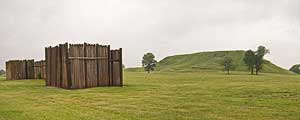 |
| Monks Mound from the side with a portion of a recreated fence that surrounded the city. |
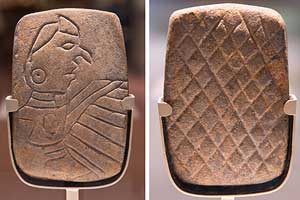 |
| The Birdman Tablet |
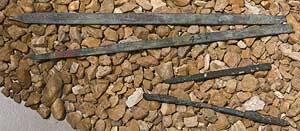 |
| Copper Tools |
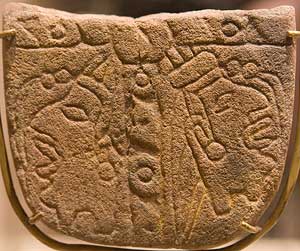 |
| Ramey Tablet |
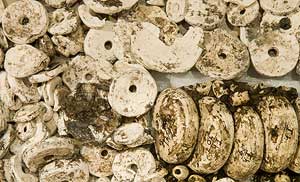 |
| Shell Beads |
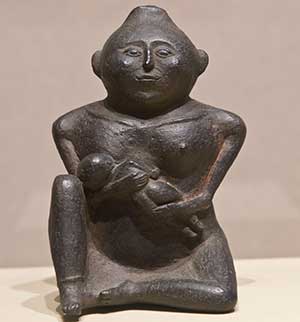 |
| Mother and Child Figurine |
Cahokia Mounds
The Cahokia Mounds are located in Collinsville, Illinois at the state's southern tip opposite St. Louis, Missouri on the Mississippi River floodplain . It is an ancient city, spanning over 120 mounds in six square miles, approximately 2,200 acres. 80 of those mounds have survived to this day. The people moved over an estimated 55 million cubic feet of earth in woven baskets to create the network of mounds and community plazas. The space is elaborate. Between the astronomical structure known as Woodhenge and the number of mounds and burials, the site suggests a complex and sophisticated society.
Monks Mound is the largest prehistoric earthen structure in North America spanning an area of nearly 14 acres and towering 10 stories, or 100 ft, tall. Once there was a large building on top of Monks Mound, possibly a temple or the home of the chief. It may have measured about 5,000 square feet and 50 feet high. In addition to being the largest mound in North America it is the largest pre-columbian earthen structure in all of the Americas. Monks Mound is a testament to the sophisticated engineering skills of these people. To the south of Monk's Mound are 40 acres of flat land. This land was originally thought to be a natural formation, but further investigation showed that it was leveled and filled anciently. It is the largest of four similar plazas in other areas of the Cahokia Mounds. Many structures and mounds are surrounded by remains of watchtowers and defensive structures, suggesting the area was used defensively at some time.
To the west of Monk's Mound is Woodhenge, a circle of posts used for astronomy observance. The placing of the posts marks the solstices and other astronomical occurrences like its European counterpart Stonehenge. More than one Woodhenge has been discovered at the site.
History
The Cahokia Mounds were discovered by French explorers in the 1600s. At the time they were inhabited by the Cahokia people, hence the mounds received their name. Since then the mounds have been frequently excavated. In 1964 the site was made a National Historic Land. In 1982 it was designated a World Heritage Site, one of only twenty in the United States. Other World Heritage Sites include the Chaco Culture National Historical Park, the Statue of Liberty, and Mesa Verde National Park. Excavations in the last decade have shown the site to have had a copper workshop. That makes it the only known copper workshop from the Mississippian era. The park is currently managed by the Illinois Historic Preservation Agency.Origin
The Cahokia Mounds were first built and peopled around 600 AD. By 1050 AD it was the major center for the Mississippian culture with many satellite communities, villages and farmsteads. It began to decline around 1300 AD and was completely deserted by 1400 AD. The decline of the Mississippian culture in that area was possibly due to over-hunting and deforestation, warfare or disease. The site was later re-populated by the Cahokia Indians (of the Illinois confederacy) in the late 1600s and it is from them that the site derives its name. It is unknown if the Cahokia Indians are descendants of the original builders or not.Artifacts
Many artifacts have been found at the Cahokia Mounds. These artifacts include pottery, tools, stones, shells, knives, arrowheads, and tattoo kits. Many games have been found as well, including balls, rings, hoops, and pins. Even some dice and gambling games have been discovered. Marine shells from the Gulf of Mexico and the Atlantic Ocean have been discovered. Also common are rocks and minerals from all over the United States, including the Smoky Mountains. Copper has been found from Michigan. All of these occurrences suggest a high trade among the Mississippian culture and the Cahokia Indians. One artifact of interest is the Birdman Tablet, a tablet depicting the head of a man, the wings of a bird, and diagonal lines crisscrossing on the back of the tablet, possibly representing a snake. This would fit with the idea of three worlds, birds representing heaven, the man representing the mortal realm, and the snake corresponding to the underworld.